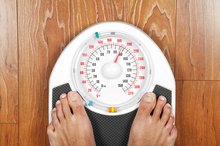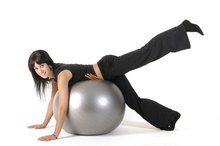What does fact checked mean?
At Healthfully, we strive to deliver objective content that is accurate and up-to-date. Our team periodically reviews articles in order to ensure content quality. The sources cited below consist of evidence from peer-reviewed journals, prominent medical organizations, academic associations, and government data.
The information contained on this site is for informational purposes only, and should not be used as a substitute for the advice of a professional health care provider. Please check with the appropriate physician regarding health questions and concerns. Although we strive to deliver accurate and up-to-date information, no guarantee to that effect is made.
What Is the Difference Between Calisthenics & Aerobics?
Calisthenics and aerobics both contribute to your goals to become fitter, stronger, leaner and healthier.
Aerobics is typically defined as any vigorous exercise that gets your heart rate up, burns calories and strengthens your lungs and heart. Calisthenics, on the other hand, uses your own body weight as resistance to strengthen the muscles.
Aerobic Exercise
During aerobic exercise, your heart rate rises, you break a sweat and you breathe harder 1. Your cardiovascular system works to deliver fresh blood and oxygen to your working muscles. With successive bouts of aerobic exercise, your heart and lungs become stronger 1.
During aerobics, your body burns calories for energy from the food you eat. If you balance your calorie intake with your exercise output, you maintain your weight; if you burn more calories than you eat, you lose weight.
Other benefits of aerobic exercise include stronger muscles and bones, improved circulation, and increased energy and endurance 1. Regular aerobic exercise also improves your cardiovascular health, decreasing the risk of heart disease and lowering blood pressure 1. In addition, aerobic exercise can reduce stress, relieve depression and anxiety and improve sleep 1.
- During aerobic exercise, your heart rate rises, you break a sweat and you breathe harder 1.
- If you balance your calorie intake with your exercise output, you maintain your weight; if you burn more calories than you eat, you lose weight.
Examples of Aerobic Exercise
Side Effects of Rapid Weight Gain
Learn More
Aerobic exercise is typically categorized into low-impact and high-impact 1.
Low-impact aerobic exercise puts less stress on your joints, which is better for people with knee problems or those who are very overweight 1. Examples of low-impact aerobic activities include walking, swimming, bicycling, rowing and using an elliptical trainer.
High-impact exercise is just as good for you as low-impact exercise, assuming you don't have any joint problems and you're not very overweight. Examples of high-impact aerobic activities include running, jumping rope or taking aerobics classes that involve a lot of leaps and jumps.
Aerobic exercise can be made more challenging by increasing the speed or the duration of the exercise 1. You can also add resistance to many exercises, such as walking or biking up hills.
It's generally recommended that you do aerobic exercise for 20 to 60 minutes several times a week, although it can be broken up into smaller chunks of time 1. How long you need to do aerobics also depends on the intensity -- if you work harder, you don't have to work as long.
- Aerobic exercise is typically categorized into low-impact and high-impact 1.
- It's generally recommended that you do aerobic exercise for 20 to 60 minutes several times a week, although it can be broken up into smaller chunks of time 1.
Calisthenics
Calisthenics involves performing movements that use your own body weight for resistance in order to increase muscle strength and size.
When you perform repetitive movements against resistance, you cause tiny tears in the muscles. When the muscle tissue heals it becomes stronger and, in some cases, larger.
But the benefits don't end there. Building muscle increases your metabolism, because your body expends calories to build and maintain muscle mass; it doesn't do that with fat. The more muscle you build with calisthenics, the more efficient your metabolism.
Done quickly enough with few rest breaks, calisthenics also provides a good cardiovascular workout and improves endurance. In fact, a vigorous calisthenics workout can actually be more challenging for your cardiovascular system and burn more calories than many aerobics workouts because you're recruiting more muscles at once.
In addition, calisthenics provides many of the mind-body benefits of aerobic exercise, including reduced depression and anxiety, improved self-image and confidence and better sleep 1.
- Calisthenics involves performing movements that use your own body weight for resistance in order to increase muscle strength and size.
- In fact, a vigorous calisthenics workout can actually be more challenging for your cardiovascular system and burn more calories than many aerobics workouts because you're recruiting more muscles at once.
Examples of Calisthenics Exercises
How Many Calories Are Burned Doing Kenpo & P90x?
Learn More
Calisthenics exercises typically target one or several muscle groups. For example push-ups target the arms, abs and chest, while squats target the butt and thighs.
Common upper body calisthenics exercises include push-ups, pull-ups, chin-ups, dips and handstand push-ups.
For the lower body, there are squats, lunges, pistol squats and heel raises. There are also many exercises to work the core muscles of the midsection, including planks, crunches and supermans.
Whereas aerobic exercise is done for a long period of time, typically 20 minutes or more, calisthenics are done for a certain number of reps or for short periods of time 1. Depending on your fitness level and the particular exercise, you might do sets of between eight and 20 reps. Then, after a brief rest, you'd do another one to four sets.
Calisthenics should be done at least two days a week to target all your major muscle groups.
- Calisthenics exercises typically target one or several muscle groups.
- There are also many exercises to work the core muscles of the midsection, including planks, crunches and supermans.
Related Articles
References
- Cleveland Clinic: Aerobic Exercise
- Veterans Health Administration: Calisthenics
- Duke University: Aerobic Exercise Trumps Resistance Training for Weight and Fat Loss
- Journal of Sport Rehabilitation: Effects of Calisthenics and Pilates Exercises on Coordination and Proprioception in Adult Women: Randomized Controlled Trial
- University of New Mexico: The Physiological Effects of Aquatic Exercise
Resources
Writer Bio
Morgan Rush is a California journalist specializing in news, business writing, fitness and travel. He's written for numerous publications at the national, state and local level, including newspapers, magazines and websites. Rush holds a Bachelor of Arts from the University of California, San Diego.









